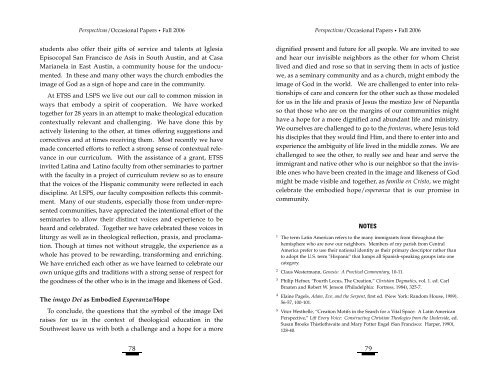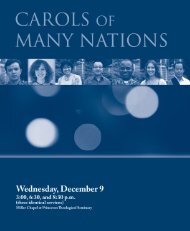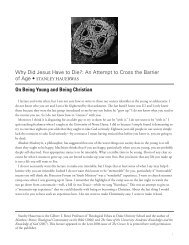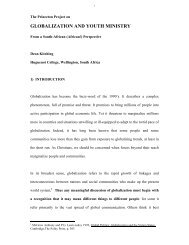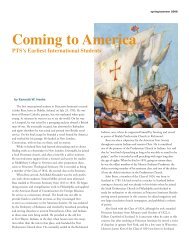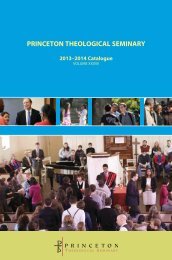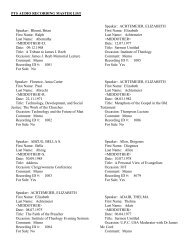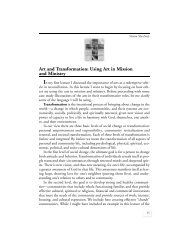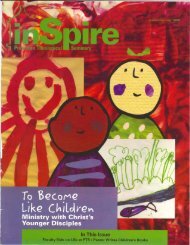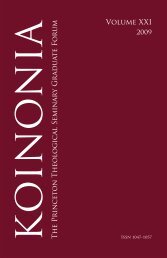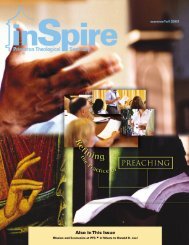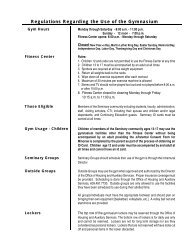P E R S P E C T I VAS - Princeton Theological Seminary
P E R S P E C T I VAS - Princeton Theological Seminary
P E R S P E C T I VAS - Princeton Theological Seminary
Create successful ePaper yourself
Turn your PDF publications into a flip-book with our unique Google optimized e-Paper software.
Perspectivas/Occasional Papers • Fall 2006Perspectivas/Occasional Papers • Fall 2006students also offer their gifts of service and talents at IglesiaEpisocopal San Francisco de Asís in South Austin, and at CasaMarianela in East Austin, a community house for the undocumented.In these and many other ways the church embodies theimage of God as a sign of hope and care in the community.At ETSS and LSPS we live out our call to common mission inways that embody a spirit of cooperation. We have workedtogether for 28 years in an attempt to make theological educationcontextually relevant and challenging. We have done this byactively listening to the other, at times offering suggestions andcorrectives and at times receiving them. Most recently we havemade concerted efforts to reflect a strong sense of contextual relevancein our curriculum. With the assistance of a grant, ETSSinvited Latina and Latino faculty from other seminaries to partnerwith the faculty in a project of curriculum review so as to ensurethat the voices of the Hispanic community were reflected in eachdiscipline. At LSPS, our faculty composition reflects this commitment.Many of our students, especially those from under-representedcommunities, have appreciated the intentional effort of theseminaries to allow their distinct voices and experience to beheard and celebrated. Together we have celebrated these voices inliturgy as well as in theological reflection, praxis, and proclamation.Though at times not without struggle, the experience as awhole has proved to be rewarding, transforming and enriching.We have enriched each other as we have learned to celebrate ourown unique gifts and traditions with a strong sense of respect forthe goodness of the other who is in the image and likeness of God.The imago Dei as Embodied Esperanza/HopeTo conclude, the questions that the symbol of the image Deiraises for us in the context of theological education in theSouthwest leave us with both a challenge and a hope for a more78dignified present and future for all people. We are invited to seeand hear our invisible neighbors as the other for whom Christlived and died and rose so that in serving them in acts of justicewe, as a seminary community and as a church, might embody theimage of God in the world. We are challenged to enter into relationshipsof care and concern for the other such as those modeledfor us in the life and praxis of Jesus the mestizo Jew of Nepantlaso that those who are on the margins of our communities mighthave a hope for a more dignified and abundant life and ministry.We ourselves are challenged to go to the fronteras, where Jesus toldhis disciples that they would find Him, and there to enter into andexperience the ambiguity of life lived in the middle zones. We arechallenged to see the other, to really see and hear and serve theimmigrant and native other who is our neighbor so that the invisibleones who have been created in the image and likeness of Godmight be made visible and together, as familia en Cristo, we mightcelebrate the embodied hope/esperanza that is our promise incommunity.NOTES1 The term Latin American refers to the many immigrants from throughout thehemisphere who are now our neighbors. Members of my parish from CentralAmerica prefer to use their national identity as their primary descriptor rather thanto adopt the U.S. term "Hispanic" that lumps all Spanish-speaking groups into onecategory.2 Claus Westermann, Genesis: A Practical Commentary, 10-11.3 Philip Hefner, “Fourth Locus, The Creation,” Christian Dogmatics, vol. 1. ed. CarlBraaten and Robert W. Jenson (Philadelphia: Fortress, 1984), 325-7.4 Elaine Pagels, Adam, Eve, and the Serpent, first ed. (New York: Random House, 1989),56-57, 100-101.5 Vitor Westhelle, “Creation Motifs in the Search for a Vital Space: A Latin AmericanPerspective,” Lift Every Voice: Constructing Christian Theologies from the Underside, ed.Susan Brooks Thistlethwaite and Mary Potter Engel (San Francisco: Harper, 1990),128-40.79


